
David Farley
A journey to Vietnam to uncover the origins of pho
My glasses steamed up as the aroma of cardamom, cinnamon, and ginger rose from the hot soup in front of me. As I was about to plunge my chopsticks into the bowl of rice noodles and thinly sliced beef, a voice cut through Hanoi’s scooter traffic: “Excuse me.” I looked up to find a bespectacled fortysomething Vietnamese man seated several feet away. “How did you hear about this place?” Before I could even answer, he added, “No foreigners come here. No one knows about it except locals and hardcore phở lovers.”
Without saying it in so many words, he was telling me I just may have found the best phở in Hanoi, if not all of Vietnam.

A phở restaurant in the Old Quarter neighborhood of Hanoi.
It wasn’t by accident. My journey to this diminutive spot in Hanoi’s Old Quarter was weeks in the making: a detour-laden, calorie-loaded expedition that was as curvy as a freshly boiled rice noodle.
Despite traveling to Vietnam a half dozen times to write about the cuisine, until now I had overlooked phở as a subject, perhaps because of its ubiquity on every Vietnamese restaurant menu. But one day while enjoying a bowl of it in New York City, I thought: Phở is the national dish of Vietnam, devoured from Ha Long Bay to the Mekong Delta. But where did it actually originate?
I knew its roots were in northern Vietnam. I also knew that phở bắc – northern phở – is different from the phở I’d been eating most of my life. In the U.S., we’re usually served the southern Vietnamese version, whose broth is sweeter and more herbaceous, and the dish comes with a side of sprouts, Thai basil, cilantro, hoisin sauce, sriracha, and jalapeño. In the north, the broth lacks the same sweetness, and the side accompaniments are usually pickled garlic and sliced red hot peppers. I’d fallen hard for northern-style phở.
When I asked friends in Vietnam about its origins, their responses varied. Some said phở – most easily pronounced fuh for English speakers – was first created in Hanoi. Others pointed to an outlying province. To complicate matters, theories differed about the influence of French colonialism and Chinese occupation. To trace the soup’s roots, not to mention find the best bowl of phở in Vietnam, I decided to make a pilgrimage to the capital, Hanoi.
I have a habit of doing such things. I’ve searched for the origins of pasta carbonara in Rome, the roots of pad thai in Bangkok, and the causality of Viet-Cajun cuisine in New Orleans. Why? I chalk it up to curiosity and my love of food and culture. There are few better ways I can imagine spending my one wild and precious life.
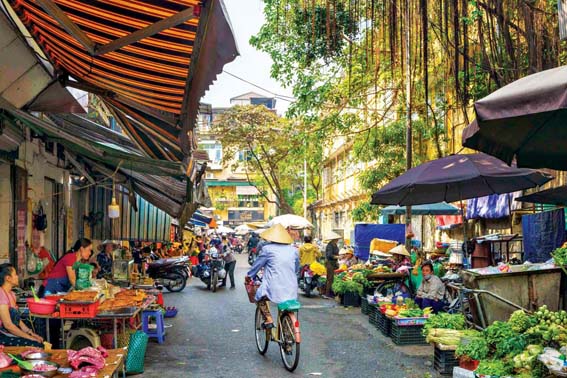
Đồng Xuân Market in central Hanoi sells all the ingredients needed for phở.
Upon arriving in Hanoi, a metropolis of 8 million people, I dove right in, eating phở every day for breakfast – the most common time it’s eaten in Vietnam – and often for lunch or a late-night dinner. On my third morning, I ventured into the late 19th-century Đồng Xuân Market in central Hanoi. Joining me were two local friends, Nguyễn Hoàng Yến and Phan Lê, who work at the famed Hanoi restaurant Madame Hien. Stalls selling everything from pigs’ feet to tropical fruit crammed the market’s three floors.

A market vendor trims spring onions.
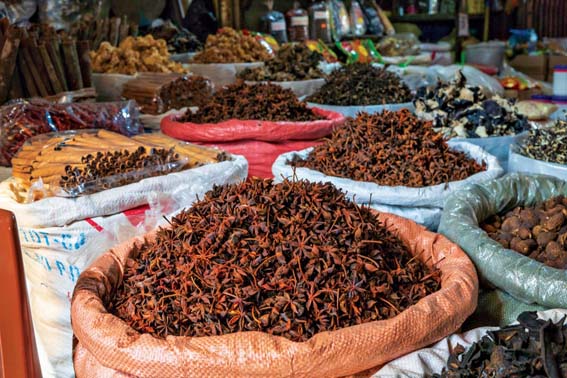
Spices fill bins at Đồng Xuân Market in Hanoi.
My friends pointed out phở ingredients for sale: cuts of beef and freshly made rice noodles, dried black cardamom, star anise, cinnamon sticks, and sá sùng, or dried peanut worm, which gives northern phở a dose of umami. Nguyễn fanned her arms at the buzzing food stalls and said, “You could say this is where phở begins.”
“Wait,” I said. “Is this where phở originated?”
Nguyễn laughed. “No, no,” she said, “but you could get all the ingredients here. If you want to find the origins, you must go to Nam Ðịnh province and a village called Vân Cù.”
It takes a village
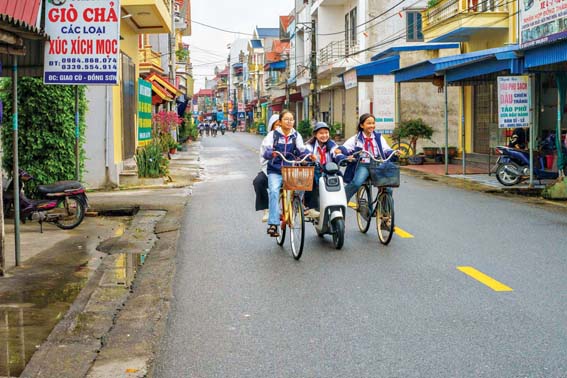
Children ride through the streets of Vân Cù village in Nam Ðịnh province.
Two days later, I steered my rental car to the small town about 70 miles southeast of Hanoi.
In an effort to promote the town as the birthplace of phở and to attract visitors, locals had recently launched the annual Vân Cù Phở Festival. Vân Cù’s phở is similar to Hanoi’s but has more pronounced seasoning and a liberal dose of fish sauce. Local entrepreneur Cồ Như Đồi spearheaded the effort, so when I arrived in town on a drizzly morning, I went straight to his house. He greeted me wearing jeans, a T-shirt, and a cardigan, and wasted no time in preparing tea.
A fourth-generation phở maker, Cồ said he helped found the festival to bring attention to his town’s place in food history, but he admitted there’s no written evidence that phở began in Vân Cù.
“For us, cows and bulls were prized work animals and not slaughtered for meat unless the beast was close to dying or there was cause for a major celebration,” he said. Enter the French, who occupied Vietnam and other parts of what was known as French Indochina from 1887 to 1954. “The French, though, have a love of beef,” he said, “and so we started slaughtering cows for them.”
Eventually, Cồ explained, people in Vân Cù – specifically, someone also with the last name of Cồ, the most common name in the town – began foraging for discarded bovine bones outside of French butcher shops. Soon, those bones found their way into a broth – along with thinly sliced beef, rice noodles, and spices.
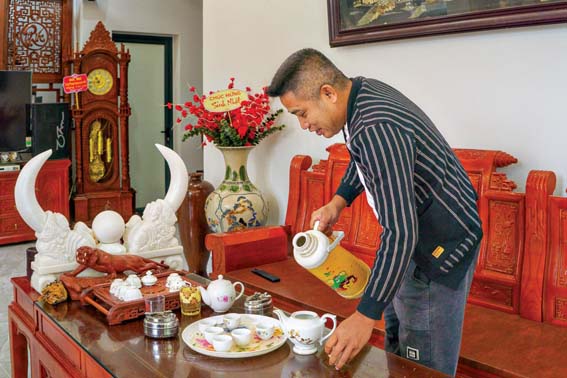
Local entrepreneur Cồ Như Đồi serves tea at his home in Vân Cù,
which bills itself as the birthplace of phở.
The recipe spread throughout Nam Ðịnh, where French colonialists had established large textile and garment factories that forced people from villages to relocate for work. “At this point in the late 19th and early 20th centuries,” Cồ said, sipping his tea, “phở was still unknown outside of Nam Ðịnh.”
But he hadn’t finished his story. The 1899 construction of the Long Biên Bridge across the Red River in Hanoi brought hundreds of workers from Nam Ðịnh who also brought their love of phở.
As a result, some cooks in Nam Ðịnh, specifically in Vân Cù, followed them to Hanoi, catering to this new demand for beef noodle soup. Some sold phở by wandering the capital’s streets with a long pole on their shoulders balanced by a container of rice noodles, beef, and herbs on one side, and on the other, a pot of broth with a wood fire underneath. A few others opened phở restaurants in the Old Quarter.
“The very first phở restaurant in Hanoi was run by Cồ Như Chiêu, a chef from Vân Cù. In this village, we almost all have the same name because we’re basically all related,” he said, chuckling.
After I said farewell to Cồ, I strolled through the town, wondering if I might find a good place to sample the soup in its supposed birthplace. In the town center, I encountered an ornate, gold-colored gate inscribed with the words “cradle of phở.” There, I randomly met Cồ Hữu Nghị, a lifelong resident. I asked him about the monument. “We wanted to show our gratitude that phở became the national dish of Vietnam and is eaten and enjoyed all over the world.” He gestured at the ground. “And it started right here.”
I asked him where I should try phở in town. Then came an unexpected twist. “Everyone in Vân Cù makes their own phở at home,” he said. “That’s why we don’t eat it at restaurants in the village very much. Many generations of people from Vân Cù have left to open phở restaurants elsewhere in Vietnam, especially in Hanoi. If you want to eat phở from its birthplace, look for a phở place in Hanoi with ‘Cồ’ in the name. That last name is now synonymous with great phở.”
Phở goes global
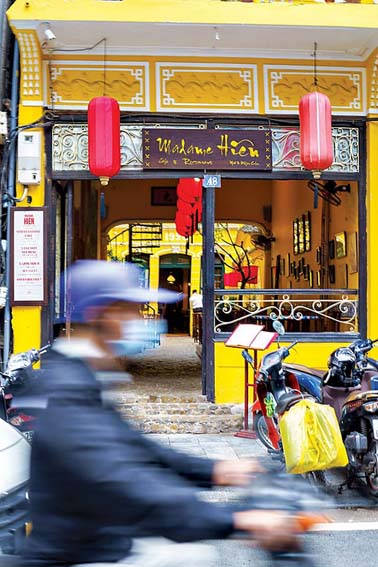
A motor scooter races past acclaimed Hanoi restaurant Madame Hien.
Back in Hanoi the next day, I continued my investigation by meeting up with French-born chef Didier Corlou in his restaurant, Madame Hien. Corlou has been cooking in the city since 1991, and I’d first met him in Hanoi about a decade ago. He loves talking about the history of Vietnamese cuisine. He agreed that phở originated in Nam Ðịnh province, and in Vân Cù, in particular. “Whatever the case,” Corlou said, “the best phở on the planet is from Hanoi.”
As he mixed spices near the restaurant’s kitchen, he mentioned the influence of the Chinese. “The main five spices in phở [cardamom, star anise, cinnamon, coriander seeds, and cloves] are essentially Chinese five spice, brought here when the Chinese occupied Vietnam hundreds of years ago.”
And what of any French influence? While many Vietnamese deny any Gallic involvement in the origins of the dish, Corlou pointed out that the charring of ginger and shallots for the broth is a very French technique, similar to the way the French prepare pot-au-feu (beef and vegetable stew).

French-born chef Didion Corlou mixes spices in his restaurant, Madame Hien.
In fact, he said, the name phở could have come from pot-au-feu, the latter word meaning fire in French. As Corlou explained, roving phở vendors in the 1920s and ’30s carried a fire-heated earthenware pot called a “coffre-feu” in French. Hungry locals would say “feu” to ask if the soup was available. That, he said, is how the name phở caught on.
Phở remained a northern dish until the end of the French Colonial period in 1954, when Vietnam split in two. Northerners who didn’t want to live under a communist regime fled to the south and brought phở with them – and so began its ascent as the national dish. When the Vietnam War – or the “American War,” as it’s called here – ended in 1975, tens of thousands of southern Vietnamese fled a reunited and communist Vietnam, introducing phở to the rest of the world. That’s why, if you’re having phở outside of Vietnam, you’re likely eating the southern version.
Putting the ‘Cồ’ in Vietnamese cooking
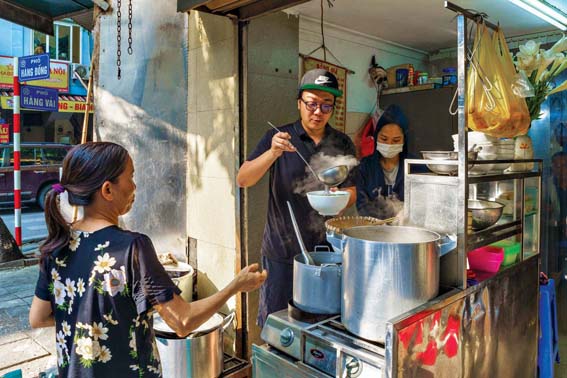
Cồ Việt Hải serves a bowl at Phở Bò Việt Hòa Cụ Chiêu.
I still wanted to find a vendor from Vân Cù in Hanoi. My friend Nguyễn Hùng Quân told me about a place in the Old Quarter run by a family from Vân Cù. At Phở Bò Việt Hòa Cụ Chiêu, I plopped down on a tiny stool and ordered a bowl with chín and tái, cooked and raw meat, respectively. About 30 seconds later, the cook slid a bowl of phở in front of me. That’s when the enthusiastic local interrupted me, amazed that I – a foreigner – had found this place.
“Look at the broth,” the local said. “It’s clear. That’s very unusual, especially when you cook with the flavorful spine bones of a cow. I’ve asked how they keep the broth so clear and yet so flavorful, but they told me it’s a family secret.”
With my first sip, I detected cinnamon and star anise at the back of my palate, and the pop of cardamom on my tongue. Then came the meat, which was fresh and tender. I glanced at the mobile food cart that acts as a kitchen and saw one of the owners chopping beef as he prepared each order, which helped explain why the meat was so good. This was, by far, the best bowl of phở I’d had all week, perhaps all my life.

Diners slurp the soup at Phở Bò Việt Hòa Cụ Chiêu, which served the author’s favorite phở.
After the meal, as I was paying – a mere 60,000 Vietnamese dong, or about $2.30 – I asked two of the owners, Cồ Việt Hải and his mother, Nguyễn Thị Xuân Hòa, if they were really from Vân Cù. He seemed surprised that a foreigner knew of his hometown. “Yes, my grandfather moved here from Vân Cù and opened the first Vân Cù phở restaurant in Hanoi,” the son said. Now it all made sense: Cồ Như Chiêu, his grandfather, was the near-mythical Vân Cù local who moved to Hanoi 100 or so years ago to open a phở place. This very place.
I asked if they believed phở really originated in the village of Vân Cù.

The author’s favorite bowl of phở from Phở Bò Việt Hòa Cụ Chiêu.
“No, it’s a bit more complicated than that,” Nguyễn said, surprising me. I braced myself for yet another plot twist. “A form of phở started in Vân Cù, but it really took shape in Hanoi, thanks to people from Vân Cù.” Phở evolved in Hanoi to have a much lighter broth with less fish sauce, she said. Many people from Vân Cù moved to Hanoi early in the 20th century, she added, and they saw an opportunity to make beef noodle soup that only the rich and the French could afford. “Phở might be for everyone today, but 100 years ago,” Nguyễn said, “it was a dish for the wealthy.”
That made sense. While everyone agrees that phở began in northern Vietnam, there may never be a consensus on exactly where. But one thing is certain: Phở reflects Vietnam’s complicated history, born out of some French and Chinese influence and a lot of Vietnamese ingenuity and self-determination. It started somewhere in Nam Ðịnh, was perfected in Hanoi, and now – for very good reason – is beloved all over the world.
If you go
Phở Bò Việt Hòa Cụ Chiêu restaurant is located in Hanoi on Hàng Đồng street near the cross street of Phố Hàng Vải.
David Farley | Photographs by Ivana Larrosa September 16, 2025
Bron: ace.aaa.com, 16.09.2025
Direct link: https://caidinh.com/Archiefpagina/Culiterair/ajourneytovietnamto.html